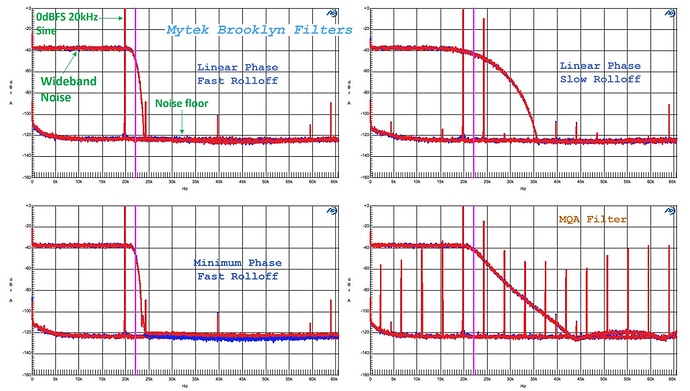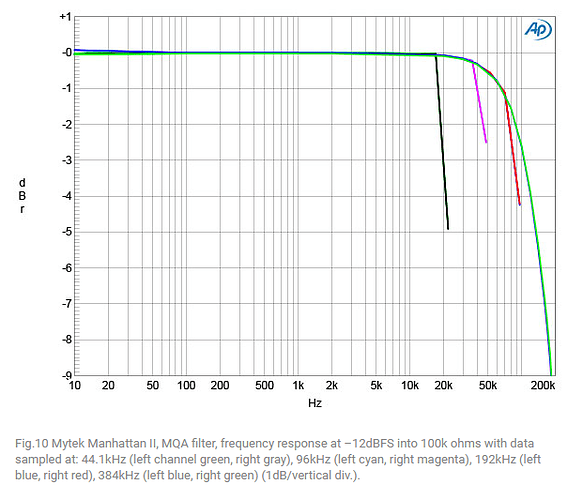You have repeated this many times, what is the source of this information?
Looks at the graph below. The famous orange ‘triangle’

It fall in the region A and B but it NEVER extend to C. A+B gives an effective resolution of 17.2bit at 96k sampling which translated to a maximum 48kHz bandwidth. This is what happens in the MQA, and that’s reason why it ALWAYS output 88.2/96k (MQA core). You may want to ask yourself why MQA requires a decoder + renderer? If the decoder can take it to ‘C’ then there’s NO need to have renderer.
My complaint is that in this diagram, and in the accompanying descriptions, the term “encapsulation” refers to picking up information from the 48 - 96 kHz frequency range, reducing it, and packing it (in two steps) into the folded file, from which it is later extracted and restored. That description is not consistent with the claim that sound above 48 kHz (I.e. 96 kHz sampling rate) is processed only through upsampling.
This is not a matter of nuance. It is a sharp and absolute contradiction.
So the original description was misleading (what we call a “lie’), or it was correct at the time but the implementation changed (which happens but should be acknowledged), or the upsampling claim is incorrect. There doesn’t seem to be any other possibility.
@Brian and @Danny, you gave inside information which I understand you may not be able to divulge, but do you agree with my summary that those are the only possibilities? And can you comment further? Specifically, can you confirm that the signaling information that you restore for downstream use by a renderer consists only of filtering specifications, and not any data stream-derived bit sequence?
This goes slightly above above 48Hz so needs more than just the first unfolding. Also this was just an example of a typical file. The original AES paper stated that the highest point they have found so far goes up to 60hz.
Also from this it does not sound like upsampling:
The idea that it is all upsampling after the first unfold does not seem to come from MQA.
Thanks, yes that works. Although on the Tidal version I found, all but the last two tracks were marked “5.1 mix”, don’t know what that means for this file.
I did that comparison:
- Device unfolding and rendering to 192
- Roon unfolding and upsampling to 192
- Roon unfolding to 96
- Redbook version 44 (Meridian upsamples to 88)
Small differences. And with music like this, heavily processed, how can I tell what is “correct”?
But I did feel that the drum hits behind the vocal, 45” - 1”10” into Up & Up, sounded crisper on the hardware decoded, proper MQA version.
So that is disturbing, not the result I wanted, because I won’t give up DSP room correction so hardware decoding is out. If indeed it is the MQA rendering that is better than generic upsampling, I will have to wait for a Meridian fix.
(Btw, this simple test turns out to be more difficult than expected. With Roon upsampling, I got the red light warning for overload so I had to reduce the headroom protection, but that disables hardware MQA so I had to remove that, and now the hardware MQA is louder, or the software upsampling is clipped.)
This list has the original resolution of the files in it. This should help you find something you like at 192 that is less processed.
Partially lossy CODEC? Is that like a partial zero emission vehicle?
This doesn’t apply to the Pro-Ject S2 DAC. So I don’t believe this comment applies to all MQA DACs.
Unless I misunderstood (highly likely).
Edit: I could be wrong. Will double check.
I haven’t seen anybody use that term, but the BMW i3 running on electric all the time but with an emergence, get-me-home gas engine…?
Anyway, if we are absolutist, MQA is lossy, just like Redbook (loses frequencies above 20k and detail below 96 dB DR), and 24/96 and 24/192, and DSD, and vinyl, and just like the microphones, and just like 2-channel stereo reproduction.
Yes and MQA is less lossy than Rebook, which many seem to forget about when criticizing MQA for being lossy.
The term lossy in Audio in the past has been used to mean less than Rebook where information in the hearing range has been lost.
Furthermore Bob Stuart argues that its maintenance of time dowman information makes it less lossy in the anologue domain than other high resolution formats. Hard to prove this one one way or the other at the moment.
I’m surprised. What does it display then?
Certified MQA playback devices should display the original MQA sample rate (of the master), not its core decoded rate or rendering rate. For a MQA 44.1kHz music, it should display 44.1kHz regardless of what it becomes after decoding and rendering.
From my very poor memory, a Tidal MQA 44k album shows as 88k on the S2 DAC’s display?
I don’t have it with me right now (I gave it to the old man) but will double check with him later this evening - not for any urgent reason, just for sh!t$ and giggles.
I now have a nervous feeling I’m wrong though 
I think your old man is about my age, so I jump every time I see that expression…
Ha he doesn’t seem to care what I call him… probably because of the amount of free gear he gets from me…
First unfold happens at MQA core at 88.2/96k, the bandwidth is limited to 48kHz, it does not extend to 60kHz as claimed by MQA. MQA filter stop band happens at 48kHz. See below.
If the MQA filter cut off at 48kHz bandwidth, there’s no information beyond that to unfold, so doing the renderering or up-sampling is used to go beyond that.
If you use Tidal app and enable MQA decoding, then S2 will display the MQA core output at 88.2/96k. I believe S2 may not function as a renderer alone but decoder+renderer in one. You need to set Tidal app as MQA pass through then S2 will display ORFS (Original Sampling Frequency).
I don’t think these charts tell you that there is no information above 48kHz with the MQA filter. There is no legend with these so it is not clear exactly what they are but by the same logic you are applying to the MQA filter with the LPFR filter and the MPFR filters there is no information above around 24kHz so pretty much anything above that is “upsampled” with those filters.
I’m not sure but I think the white noise input signal in the charts you posted is cut off at 20kHz. (Look at the green writing on the first chart.) White noise is often defined as noise that has the same intensity throughout the audible band. Perhaps someone who knows more can clarify.
I can’t find frequency response measurements for the Mytek Brooklyn MQA filters but for the Manhattan II the MQA filters show information well above 48kHz with higher sampling rates, similar to other Mytek filters with both the Booklyn and the Manhattan.
See this for more.
I think “PZEV” is a Subaru trademark. It struck me as manifestly silly when I saw it. Either it’s zero emission or not, right?
OK I get that Red Book encodes what was believed relevant when it was spec’d, with an absolute Nyquist limit of 0-22,000 kHz and a theoretical distortion limit of -96dB. In theory, an end-to-end system–analog in, analog out–could produce results that are better objectively, subjectively or both (for example it could use a nonlinear encoding scheme). So rating it in terms of Shannon limits may miss the point.
That being said, after reading this thread I am more confused than before as to what the intent of MQA is. If it’s not “digital rights management” what is it? Again I see where many systems, be they DBX or MPEG, may be “rights managed” in the sense that you have to buy or license the hardware or software from someone.
If the intent is to make–or they are being made–MQA disks in Redbook containers (technically they’re not “CD’s”) how does one play them? Do you have to buy an MQA player or can you plug an MQA DAC into your existing player? And if you had a raw MQA file in your storage media what’s to prevent it from being replicated indefinitely (unless someone installs an evil “root kit” on your operating system)? I can see where Stuart wants to rescue the undeniably moribund recording industry, but how does it accomplish this exactly?
We have now a high resolution audio format–SACD–that is basically end to end, and less rip-able than CD (I haven’‘t investigated how because, having only a few, I don’t feel the need, but I’m sure the means are around). If MQA disks aren’t’ ripable now give it thirty minutes (that’s how long it took someone to crack Blu Ray, right?) And if it’s supposedly illegal to rip them and store them on your Roon server, give it some time in the courts. It’s “fair use”, been litigated over and over again.
MQA is backward compatible so an MQA CD would play like any other. If you have an MQA DAC, you can unwrap the high res content.
This is the same for any MQA file. You can also rip it and copy it for your own use.
For now. I submit this is only an opening gambit in a long range plan.

